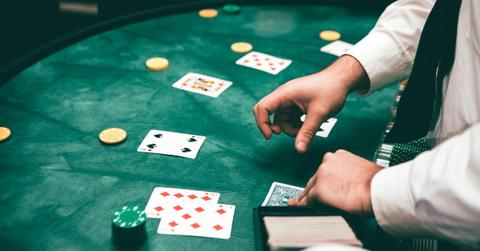 NEWS
NEWSUnderstanding Blackjack Payouts and Side Bets

Oct. 14 2024, Published 1:29 a.m. ET
Whether you look at Las Vegas or online casinos, blackjack is one of the more popular games out there because of its simple game plan and available strategies. Players love to win, and blackjack is often thought to represent a higher chance at doing so.
One of the things that give blackjack its appeal is, of course, the side bets. When you learn about side bets, blackjack becomes a much more interesting game. It's like adding a new dimension to it. In this article, you will be introduced to all kinds of side bet options, the benefits of introducing them to your blackjack strategy, their structure, and, most importantly, the payouts that follow through after you hit on a side bet.
What Are Side Bets in Blackjack?
In essence, side bets in blackjack are additional bets placed besides the standard wagers you put forth when playing this card game. Their secret lies in the act of predicting. You're not only guessing the cards that will be drawn your way, but also placing these bets on the cards the dealer is going to receive.
Side bets are put on each side of your main bet before any cards are drawn. Before you start practicing blackjack side bets, you need to know that they're a product of chance and luck and have little to do with actual proficiency in this card game.
Side bets come in a couple of forms. The main ones include Blackjack Insurance, Perfect Pairs, and 21+3. There are a few more side bets to consider, but it's best to stick to the primary ones first.
Why Engage in Side Betting When Playing Blackjack?
For those who love the game of blackjack, many believe that the odds in blackjack almost always favor the player. The house edge is much lower compared to some other casino games, both land-based and online, such as Stake.com.
When you play blackjack, and you're good at it, the house edge is close to 0.5%. Even if you're not too good at it, the house edge will not go through the roof. Instead, it almost can't go over 2%. So, when you compare the return-to-player in blackjack and similar games, it is quite favorable. You shouldn't be too surprised to hear that this is what makes online blackjack one of the most popular games in the world.
If you're now in the process of becoming a fan of this amazing card game, you should know that while the odds may be more in your favor, the same equation can't be applied to winning. At its core, blackjack is an even money game that offers a 2:1 payout if you strike a blackjack. Side bets hold the potential to increase your chances of winning. Some side bets offer payouts set at 5,000:1. Now, this is a bet worth following.
This way, it appears as a promised land for bettors. The fact is, however, that it's not all that great. With side bets, you also increase the house edge—some people believe by 10%. In a straightforward game like blackjack, this is no small increase. Do you understand the equation? With side bets, you can win more–but also lose more.
The Most Common Side Bets
Not all side bets are the same, and the same applies to different blackjack tables. They are usually printed or marked on the table next to where you place your main bet. At online casinos, they're more visible right next to your chip position. Not all casinos apply the same rules, so you must familiarize yourself with them before you place side bets. They can vary from casino to casino in a considerable amount, so it's worth reading up a bit before placing your first wager.
What most casinos have in common are the three primary types of side bets: Insurance, Perfect Pairs, and 21+3.
Insurance Blackjack Side Bet
The most common side bet, the insurance bet, comes into question under one particular condition. To have an insurance bet as your side bet, the dealer first needs to draw an Ace. With an Ace face up and your two cards on the table, you will always be allowed to insure yourself against the dealer drawing a blackjack. This side bet takes half of your initial bet and pays out 2:1 if the dealer gets 21 after only two cards are drawn. This bet reduces the house edge in blackjack even further. This is how blackjack insurance works in steps.
Step 1: First, you place your initial bet. After that, the dealer deals two cards to each of the players and two to himself, with only one being face up.
Step 2: If the one turned face up is an Ace, you are allowed to insure your bet. To place this side bet, you're required to put forth half of your original bet. It is seen as a separate bet on the table.
Step 3: The dealer reveals the second card, uncovering if it has blackjack or not. If it has a direct 21, you will win your side bet in a 2:1 ratio but lose your initial bet in the process. If the dealer doesn't have a blackjack, you lose the insurance bet, but the round continues with the hand you draw.
Perfect Pairs
Slowly and steadily comes the second most popular side bet. The Perfect Pairs side bet requires you to draw a unique set of cards. You need two of a kind. Perfect Pairs come in a few shapes. A mixed Pair, for example, two 10s, one of heart and the other of spade, will have a payout in a 5:1 ratio. A colored pair is when you have a pair of the same color but a different suit and pays out in a 12:1 ratio. A perfect pair pays out in a 25:1 ratio, and if you have a pair of heart-shaped Aces, you've hit the jackpot.
Of course, these are general rules. Every casino is entitled to a set of rules of its own, and you should learn about every particular casino and game, unique house edge, payouts, decks used, and everything in between. Depending on some of the conditions of side bets, the house edge can vary from 2% up to 11%.
21+3
Here is an interesting side bet. Why? Well, the results are numerous. 21+3 derives its name from the amount of cards you require for this bet. It consists of three cards. The two you're dealt and the one card from the dealer. With three cards, the number of combinations grows. You have a few options, some of which are similar to when you play poker online. You have:
* Flush - All three cards are of the same suit, with a payout set at a 5:1 ratio.
* Straight - The cards you have in hand and the one that the dealer has upturned need to be consecutive. A good example is having 5, 6, and 7. Straight pays at a 10:1 ratio.
* Three of a Kind - When you have three of a kind that are not of the same suit, the payout stands at 30:1.
* Straight Flush - This combo is when you hold three consecutive cards of the same suit. It pays out at a 40:1 ratio. Things are getting more interesting, right?
* Suited Triple - A side bet that has a payout set at 100:1. To hit on this side bet, you need three of a kind of the same suit. It's not an easy feat, but one that pays out quite well.
In theory, a 21+3 side bet is an amazing one. While some believe the payouts can be good, the house edge is not. Depending on the casino and the number of decks used, it can vary from 6% to almost 9%. The more decks in play, the greater the chances that you'll hit on this side bet. While Insurance, Perfect Pairs, and 21+3 are the most common side bets in blackjack, this card game has plenty more to offer. So, if these three bets are not your cup of tea, or you simply want to experience everything that blackjack could throw at you, keep reading.
Want OK! each day? Sign up here!
Additional Blackjack Side Bets
As said, the side bet adventure in blackjack doesn't end with the three most common side bets. Blackjack is a game that still attracts most players, and it does this with its diversity. What you need to remember is that these side bets are not available in every casino. So, when you learn about them and try them out, look for casinos that offer all of your favorite side bets. What unorthodox side bets does blackjack have to offer?
Royal Match Side Bet
This one is quite direct. The Royal Match side bet has a payout of 5:2 when you have two of any same-suited cards. If you have a suited King and Queen, the payout rises to 25:1. It is a fun little side bet to have from time to time if you like those numbers.
Over/Under 13 Side Bet
Over/Under sounds like a side bet sports bettors might like. It is an even-money bet in which, for a win, you need to guess if your card count will be over or under 13. Depending on the casino, you will always lose if the count is 13, while some casinos reward their players if they hit the unlucky 13.
Super Sevens Side Bet
If 13 is unlucky, then 7 must be lucky, right? In this case, it is. This is a side bet that pays out if one or more 7s are dealt to the player. If you draw only one, the payout stands at 3:1. For two 7s not of the same suit, the payout rises to an incredible 50:1, while two 7s of the same suit have a payout set at 100:1. For three unsuited 7s, a payout will be 500:1 while if you have three 7s of the same suit that number rises to 5000:1. This is another case where it's important to know which rules a casino applies to. Some casinos will deal cards to you once you hit 21, making it impossible to receive an additional 7 when you need it.
Lucky Ladies Side Bet
While 21 is the goal of blackjack, one can find its luck with 20, too. It is often enough to go to 20 when playing blackjack, and this number can become magical if you add Lucky Ladies' Side Bet to your repertoire. An unsuited combo of 20 pays out at a 4:1 ratio. If you're lucky enough to have a suited 20, you will get a 10:1 payout. Twenty, when matched, raises it to 25:1, while 20 created from two Queens of heart pays out at a 200:1 ratio. The most interesting part here is that if a dealer hits blackjack when you have this side bet, the payout is 1000:1.
Are Side Bets Worth It?
As said at the start, having side bets requires no skill. It's all a matter of chance and luck. With house edge shifting towards the casino when you play them more often, you need to think twice before you place a side bet. Yes, they could create an extra income, but having them on every bet could lead to massive losses. So, think twice before placing side bets, and do it only if you feel that luck has your back.


